 Image search results - "gion" Image search results - "gion" |

Held in July, Narita Gion Matsuri Festival has ornate floats pulled on the streets of Narita and to Narita-san temple. Pulling a float on the street
|
|

Pulling the float, Narita Gion Matsuri
|
|

Tired from walking, Narita Gion Matsuri
|
|
|
|
|
|
|
|
|
|

On July 16, the night before the Gion Matsuri Yamaboko Junko parade of floats, the Yoiyama display of floats lit up at night attract huge crowds in central Kyoto. You can also enter some of the grand floats.
|
|
|

Even before evening comes, a large crowd stop to see the Naginata-boko float at Shijo-Karasuma.
|
|

Narita Gion Matsuri
|
|

People vying to see Naginata-boko float.
|
|

Narita Gion Matsuri
|
|

Bridge to the float.
|
|
|
|

Maiko alert
|
|
|

Maiko poses in front of the Naginata-boko float across the street in Kyoto
|
|
|
|

A real crowd pleaser. Thanks for posing!
|
|

Side entrance to Narita-san temple.
|
|

Maiko pose
|
|
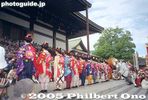
Offering prayers at Narita Gion Matsuri
|
|

Side street of food and souvenir stalls
|
|
|

Yamabushi-yama residence opened up for public display
|
|
|
|

Yamabushi-yama 山伏山
|
|

Gathering at Narita-san temple
|
|

Yamabushi-yama
|
|

Prayers at Narita-san
|
|

Tenjin-yama 天神山
|
|

Narita Gion Matsuri
|
|

Tenjin-yama
|
|
|
|

Souvenir hunters. Cheap geta clogs and yukata (made in China) are sold.
|
|
|

Geta for 600 yen
|
|
|
|

Maiko in my midst
|
|
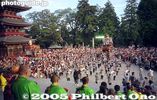
Narita-san during Narita Gion Festival
|
|

Yoshikawa
|
|
|
|

Yoshikawa: A special treat is that private residences in the old kimono merchant district open up their entryways to show folding screens, kimono, and other treasures.
|
|
|

Yoshikawa
|
|
|
|
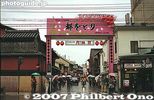
Entrance to the road leading to the Cherry Dance theater (Gion Kobu Kaburenjo) in the Gion district. The sign says "Miyako Odori."
|
|

Matsuzakaya 松坂屋
|
|
|

More signposts reading "Miyako Odori." "Miyako" means capital (Kyoto was once Japan's capital city), and "Odori" means dance.
|
|
|

Narita Gion Matsuri
|
|

"Miyako Odori" sign post. Performed for over a century, the dance makes April a very special time in Kyoto. It helps to hone the dance and musical skills of the geiko and maiko who diligently practice for this annual dance.
|
|

Teens in yukata
|
|

If you like women in yukata, see the Yoiyama (or Yoiyoiyama or Yoiyoiyoiyama during the three evenings before the main Gion Matsuri parade).
|
|

"Miyako Odori" poster in English.
|
|

"Miyako Odori" poster and paper lantern.
|
|

Side street to Minami Kannon-yama float
|
|
|

Minami Kannon-yama float
|
|

PR posters and paper lanterns for the Miyako Odori are everywhere.
|
|

Minami Kannon-yama float
|
|

Ichiriki, a famous geisha tea house.
|
|

Minami Kannon-yama float and flute players
|
|

Maiko and geisha can often be seen in Gion.
|
|

A plastic sheet protects the tapestry from rain (it was a cloudy day)
|
|

Gate to Kobu Kaburenjo Theater. Four shows daily in April, lasting about 1 hour (too short). Ticket prices range from 1900 yen to 4300 yen.
|
|

Crowd on one of the main streets
|
|

Gate to Kobu Kaburenjo Theater. You can make ticket reservations by phone, or go directly to the theater ticket office and buy tickets.
|
|
|
|

Kobu Kaburenjo Theater
|
|
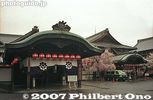
Gion Kobu Kaburenjo Theater. Ticket office is on the right. Best to buy tickets at least a few days in advance.
|
|

Crowd on Shijo-dori street
|
|

Crowd and floats on Shijo-dori street as darkness sets in.
|
|

Crowd and floats om Shijo-dori street 四条通り
|
|

Minami-Kannon Yama float
|
|

Minami-Kannon Yama float
|
|

Minami-Kannon Yama float 南観音山
|
|

Girls in yukata singing in front of Minami-Kannon Yama float to attract donors.
|
|
|

The public can enter the float through a small bridge connecting the float to a house.
|
|

I went up to the 2nd floor of the house and lined up to enter the Minami-Kannon Yama float.
|
|

People line up to enter the Minami-Kannon Yama float.
|
|

Statue of Minami-Kannon inside the house connected to the float.
|
|

Statue of Minami-Kannon inside the house connected to the float.
|
|

On the narrow bridge to the float.
|
|

On the top deck of the float where the musicians play. It is a very small space.
|
|

Front of the float with small taiko drums. They sit on a very narrow bench along the edges.
|
|

Front of the float
|
|

Bells
|
|

A pole in the middle
|
|

Ceiling
|
|

Outside view from the float
|
|

Outside view from the house connected to the float.
|
|

Outside view from the house connected to the float.
|
|

Bridge to the Minami-Kannon Yama float. 南観音山
|
|

Bridge to the Minami-Kannon Yama float. 南観音山
|
|

Bridge to the Minami-Kannon Yama float. 南観音山
|
|

Minami-Kannon Yama float. 南観音山
|
|

Minami-Kannon Yama float. 南観音山
|
|

Flute players on Minami-Kannon Yama float. 南観音山
|
|

Shijo-dori street toward Naginata float
|
|

Shijo-dori street toward Naginata float
|
|

Shijo-dori street and Naginata float. This area was the most crowded.
|
|

Shijo-dori street and Naginata float. This area was the most crowded.
|
|

Naginata float at night
|
|

Naginata float at night
|
|

Naginata float at night
|
|

Huge crowd
|
|
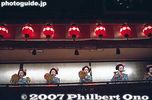
The cherry dance consists of several acts each with a different dance or play.
|
|
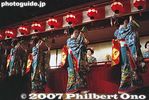
A hanamichi is also on the left side of the theater.
|
|

We were right near the hanamichi where the geisha performed.
|
|

Note that taking pictures and videos are not allowed.
|
|
|
|
|
|
|
|
|
|
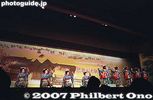
Main stage at front.
|
|
|
|
|
|
|
|
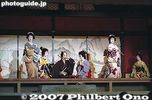
A play
|
|
|
|
|
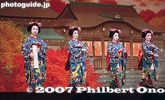
Autumn
|
|
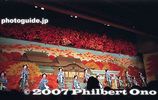
Somebody had a big head...
|
|
|
|
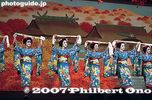
Miyako Odori, Kyoto
|
|
|
|
|
|
|
|
|
|
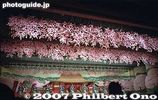
Climax with cherry blossom motif.
|
|
|
|
|
|
|
|
|
|
|
|

Cherry Dance, Kyoto.
|
|
|
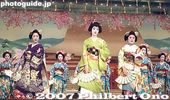
Kyoto geiko and maiko at their best for the finale.
|
|
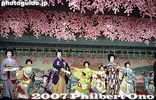
These dance photos were taken in April 2002. Note that taking pictures and videos of the dance are no longer allowed.
|
|

Gion Matsuri is one of Japan's grandest festivals. Held annually in July, the festival's climax is on the 17th and 24th when giant, wooden-wheeled floats are pulled through the streets.This is at the starting point of the Yamahoko Junko procession on July 17.
|
|

I first went to one of the starting points of the parade.
|
|

Starting at 9 am, the Naginata Hoko float always leads the procession. 長刀鉾
|
|
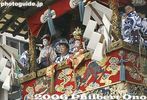
The Naginata Hoko is the only one with a live sacred child called "Chigo."長刀鉾
|
|

Naginata Hoko 長刀鉾
|
|

Naginata Hoko and chigo child 稚児長刀鉾
|
|

Naginata Hoko and chigo child 稚児
|
|

Kanko Hoko
|
|
|
|

Yama float
|
|

Tsuki Hoko (Moon Float) 月鉾
|
|

Tsuki Hoko 月鉾
|
|

Pulling the Tsuki Hoko. Also see the video at YouTube.Notice the crescent moon design on their happi coats.
|
|

Tsuki Hoko月鉾
|
|

He steers the rear wheels with a wedged stick.
|
|
|

Urade Yama float 占出山
|
|

Tapestry on Urade Yama float depicting's Japan's Scenic Trio 占出山
|
|

Pulling a float at the Kyoto Gion Matsuri.
|
|
|
|
|

The wheel's diameter is 1.9 meter.
|
|

There are nine of these giant hoko floats.
|
|

The hoko floats are about 20 meters tall.
|
|

Shijo-dori street 四条通り
|
|

Shijo-dori street is the first segment of the procession route. 四条通り
|
|

An ambulance comes through, probably with someone suffering from heat stroke.
|
|
|
|
|
|

So why does it have a tree growing on the roof?
|
|

The Fune Hoko is a unique, boat-shaped float. 船鉾
|
|

Fune Hoko boat-shaped float. 船鉾
|
|

Huge crowd watch the floats turn at the corner in front of Kyoto City Hall. 京都市役所前
|
|

A sea of people in front of Kyoto City Hall. 京都市役所前
|
|
|
|

Turning the hoko float at the Kyoto Gion Matsuri.
|
|

They are pulling floats weighing 10 tons.
|
|
|

Successful corner turn to Oike-dori street
|
|

Another float is preparing to make the turn.
|
|

The front wheels are placed on wet strips of bamboo.
|
|

When the wheels are on the bamboo strips, they pull.
|
|

Fune Hoko boat-shaped float. 船鉾
|
|

Fune Hoko boat-shaped float makes the turn.船鉾
|
|
|

The yama floats have no problem turning.
|
|
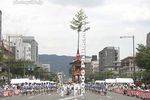
Oike-dori is a wide road and the last stretch of the procession. 御池通り
|
|

御池通り
|
|

Minami-Kannon Yama float always appears last in the parade. (This float now appears in the Ato Matsuri parade on July 24.) 南観音山
|
|

This road has paid seating, but most are empty. Probably too hot to sit over the asphalt.
|
|

At the end of the route, the last floats arrive here by 1:20 pm or so. So if you want to see the float procession, be in Kyoto by 1 pm and go to the end of the route.
|
|

Disassembly occurs soon after the procession ends.
|
|

Disassembly. The wheel axel is made of steel.
|
|

Disassembly
|
|

Gion Matsuri poster for 2004.
|
|

My video of the Gion Matsuri Saki Matsuri procession on July 17.
|
|

My video of the Gion Matsuri Ato Matsuri procession on July 24, 2014 held for the first time in 49 years.
|
|
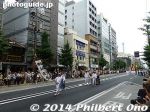
The start of the Gion Matsuri Ato Matsuri yama-hoko procession on July 24, 2014. Held 1 week after the main Saki Matsuri procession on July 17.
|
|
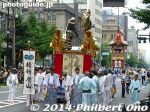
Hashi Benkei-yama 橋弁慶山 - From the famous Noh play called "Hashi Benkei," it shows the fight scene between Benkei and Ushiwakamaru at Gojo Ohashi Bridge in Kyoto.
|
|

Kita Kannon-yama 北観音山 - Worships Yoryu Kannon (揚柳観音) to dispel illness, and Idaten, a guardian deity.
|
|
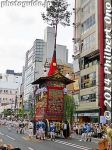
A large willow branch sticks out from the rear.
|
|
|
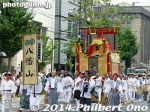
Hachiman-yama 八幡山 - Worships the god Hachiman in a miniature shrine, whose spirit was transferred from the local Hachiman-gu shrine.
|
|
|
|

Kawaramachi-dori going to Shijo-dori road.
|
|

Jomyo-yama 浄妙山
|
|
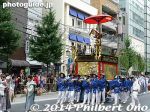
Jomyo-yama 浄妙山
|
|
|
|
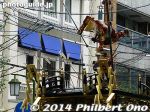
Jomyo-yama 浄妙山 - Depicts the famous 12th-century battle between the Heike and Genji Clans at Uji River in Kyoto in the Tale of the Heike. It shows warrior-monk Ichirai jumping over Jomyo to take credit as the first to engage the enemy.
|
|
|

Suzuka-yama 鈴鹿山 - Dedicated to the goddess Suzuka who lives in the Suzuka Mountains and eliminated the demon terrorizing local residents and travelers to Ise. She wears a gold eboshi hat.
|
|

Minami Kannon-yama about to turn at the Kyoto City Hall corner.
|
|
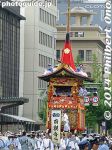
Minami Kannon-yama 南観音山 - Worships Yoryu Kannon (揚柳観音), which dispels illness. The large willow branch also dispels illness. Medicine balls are on the four corners.
|
|
|
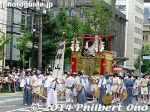
Koi-yama 鯉山 - Shows a carp (koi) swimming up a ryumon waterfall to become a dragon. The tapestries, depicting the Trojan War, were made in Belgium in the 16th century. (Important Cultural Properties)
|
|

En no Gyoja-yama 役行者山 - Depicts En-no-Gyoja, in the middle, an ascetic who had Hitokoto Nushi (standing on left) build a stone bridge between Katsuragi and Mt. Omine in Nara. On the right is the Goddess Katsuragi.
|
|

Kuronushi-yama 黒主山 - From the Noh play called "Shiga," it shows 10th-century poet Otomo no Kuronushi looking up at cherry blossoms.
|
|
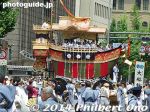
Ofune-hoko 大船鉾 - Gion Matsuri's brand new float parading for the first time today on July 24, 2014.
|
|
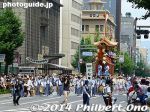
Costing over US$10 million, this float always appears last in the Ato Matsuri. It rejoins the Gion Matsuri after being absent for 150 years when the previous float was caught in a fire in 1864.
|
|
|
|
|
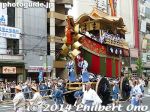
The new boat float (Ofune-hoko) rejoins the Gion Matsuri after a 150-year absence. It always appears last in the float procession.
|
|
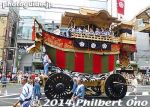
Meet Gion Matsuri's new boat float, Ofune-hoko.
|
|
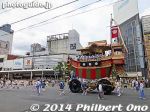
During the Ofune-hoko's 500-year history, it repeatedly suffered from fires, but was rebuilt each time until 1864 when it caught fire caused by a skirmish (Hamaguri Gate Rebellion 蛤御門の変) at the Kyoto Imperial Palace.Notice the boat rudder.
|
|

Gion Matsuri now has two boat floats. The boat float (Fune-hoko) in the Saki Matsuri procession is said to be going to battle, while the Ofune-hoko is on a triumphant return from battle. Both boat floats worship the legendary Empress Jingu.
|
|
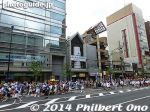
The Hanagasa Parade (花傘巡行) is a parade of mostly children and women accompanied by flowery parasol floats. It starts (10 am) and ends (noon) at Yasaka Shrine. On Kawaramachi-dori road, they follow right after the main float procession.
|
|
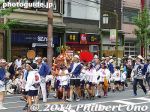
When the Saki Matsuri and Ato Matsuri's processions were combined on July 17, 1966, the Hanagasa Parade was started on July 24, 1966 to compensate for the Ato Matsuri's procession.
|
|
|
|
|
|
|
|
|